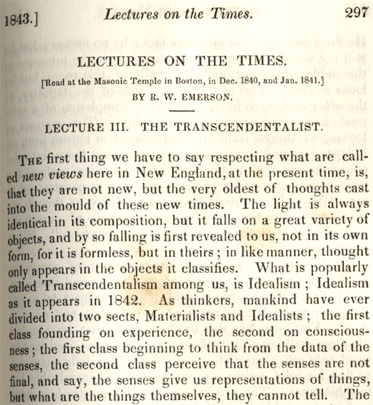 |
THE DIAL,
1840-1844
26. The Dial, 1840-1844. Letterpress on
paper; half bound in dark brown morocco and marbled paper boards; original
printed paper wrappers retained. From the Emerson collection of William
Taylor Newton, presented by Edith Emerson Forbes and Edward Waldo Emerson,
1918.
Just as the Transcendental Club served as a forum for discussion by its members of religion, philosophy, literature, and society, the quarterly periodical The Dial also kept them in dialogue with one another. The practical details of its editing and publication required frequent communication among them regarding submissions, editorial decisions, production, and finances. Although The Dial never circulated widely, it was important to the Transcendentalists as a stimulus to and medium for their thought. Emerson was a founder of, a major contributor to, and (for two years) the editor of The Dial, and his home in Concord was therefore one of the places where its business was conducted. Conceived at a meeting of the Transcendental Club on September 18, 1839, named by Bronson Alcott, The Dial was issued between 1840 and 1844. It was published in Boston, first by Weeks, Jordan and Company, then (in 1842 and 1843) by Elizabeth Peabody, finally by Emerson’s publisher James Munroe. Margaret Fuller was its first editor; Emerson took over from her in 1842. On March 23, 1842, after agreeing to take over the editorship, Emerson wrote to Frederic Henry Hedge about the difficulties faced by the periodical: “Be it known to you that our poor Dial after staggering through two years of external weakness, friendlessness, publiclessness, and publisherlessness … threatened last Saturday on an inspection that was made of its accounts—to die of atrophy. The publishers, Weeks & Jordan, were not only extremely negligent but when they became bankrupt, were much in debt … to the little Journal. Margaret Fuller has never had a penny for all her time & toil; & now J F Clarke & E P Peabody discovered that they could rely only on 300 subscribers … Very unwillingly I assume the load for a time until a better person appears, more fit for this service & more fond of it … Poor Dial! … I dare not let it perish without an effort. It wants mainly & only, some devotion on the part of its conductor to it, that it may not be the herbarium that is of dried flowers, but the vehicle of some living & advancing mind.” Despite Emerson’s hope of keeping it going, however, The Dial ceased publication with the issue for April, 1844. Emerson was a prolific contributor of poems, essays, lectures, and reviews—a total of more than seventy-five pieces—to The Dial over its four-year run, and particularly during his editorship. Other contributors included Bronson Alcott, Ellery Channing, Lydia Maria Child, James Freeman Clarke, Christopher Pearse Cranch, Margaret Fuller, Frederic Henry Hedge, James Russell Lowell, Charles King Newcomb, Theodore Parker, Elizabeth Peabody, Caroline Sturgis, Henry Thoreau, and Jones Very. One of the pieces by Emerson published in The Dial was “The Transcendentalist” (Myerson E75). Originally delivered as part of a lecture series at the Masonic Temple in Boston in 1840 and 1841, the piece—shown here—was published in the January, 1843 issue of the periodical.
No image in this online display may be reproduced in any form, including electronic, without permission from the Curator of Special Collections of the Concord Free Public Library.
Next Entry - Previous Entry - Back to Section IV Contents Listing - Back to Exhibition Introduction - Back to Exhibition Table of Contents |